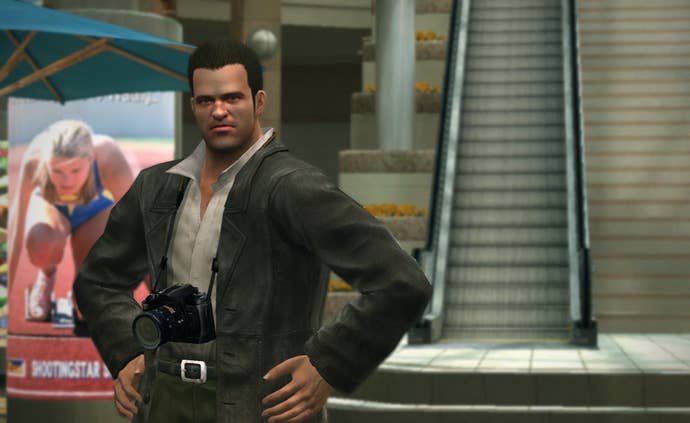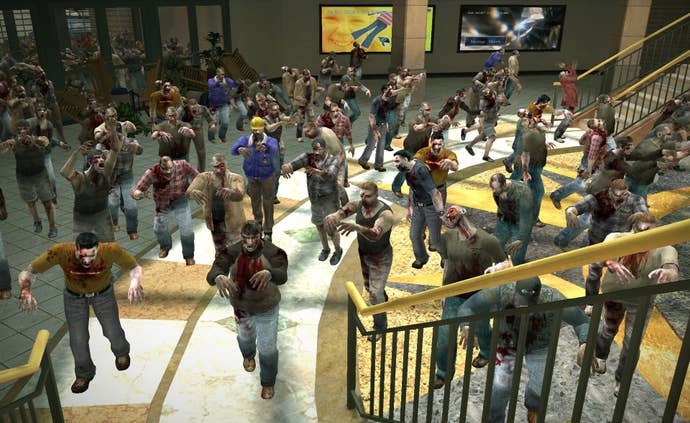10 Years Ago, Dead Rising Kicked off a Generation that Ended Up Choosing a Much Different Path
Capcom's take on Dawn of the Dead showed what the future would hold for last generation's consoles, even if few others would borrow its hardcore approach.
This article first appeared on USgamer, a partner publication of VG247. Some content, such as this article, has been migrated to VG247 for posterity after USgamer's closure - but it has not been edited or further vetted by the VG247 team.
Capcom built the original Dead Rising on the foundation of a fairly frivolous thrill: Seeing a whole bunch of stuff move around on the screen at once.
Even if the previous generation of consoles had given us a small taste of this novelty with games like Katamari Damacy and Dynasty Warriors, no one had seen anything like Dead Rising before. If anything, Capcom seemed primed to reach the logical conclusion of the astoundingly popular Grand Theft Auto III trilogy: violent, open-world mayhem delivered with a degree of fidelity that Rockstar's shoddy engine and the PlayStatio 2 hardware just couldn't muster. Little did anyone know, Dead Rising would lean more towards Resident Evil than GTA with its design sense, opting for a focus on meticulous planning and player restrictions over freewheeling murder sprees—and some people weren't particularly happy about that.

While Dead Rising might have at first seemed like a naked, cynical attempt by Capcom to capture the hearts and wallets of the West—because it kinda was—the first game's production involved high-level Capcom talent that wasn't currently on their way out the door (as Resident Evil's Shinji Mikami and Devil May Cry's Hideki Kamiya soon would be). Keiji Inafune, steward of all things Mega Man, served as executive producer, while the role of director went to a particularly unsung Capcom hero who's since ascended to "management heaven," Yoshinori Kawano. In terms of his employer's history, he certainly directed some notable games: the original Breath of Fire, the entire Mega Man Zero series (which definitely shows his penchant for particularly difficult experiences), and, of course, Mega Man Legends. It's strange to think that, in just ten short years, the latter series' plucky servbot characters will officially be in more Dead Rising games than the series that spawned them.
Anyone who bought Dead Rising for some simple, zombie-smashing fun was in for a rude awakening, though. Strangely enough, for their big-budget entry into the world of HD gaming, Capcom decided to roll with a system very similar to what's found in 2003's Breath of Fire: Dragon Quarter—one that mostly went over like a lead balloon with critics at the time. Rather than being a linear, start-to-finish experience, players have no choice but to lose multiple times in Dead Rising before reaching the true ending. Though protagonist Frank West keeps his character level and earned abilities with each restart, he's supremely underpowered throughout your first handful of playthroughs, and can only withstand just a few bites from the hordes of slow-moving zombies inhabiting the Willamette Parkview Mall. With each attempt to travel further down Dead Rising's critical path, though, your growing knowledge of the environment and three-day schedule paired with Frank's slow increase in power give you a slightly better chance of seeing the finale.

If you're a perfectionist when it comes to gaming, Dead Rising will either break or absolutely repel you. From the beginning, it's made clear that you won't be able to save everyone: Dead Rising opens with a massacre in which nearly a dozen named characters succumb to the zombie menace, leaving Frank to flee to safety. Anyone who tries to rescue every character from the beginning of their first playthrough by use of strategic saving is likely to quit out of sheer frustration, since it's literally impossible. To finish the game, you only need to be at the right place at the right time for critical events, but Dead Rising doesn't mind letting you know whenever someone dies thanks to your inaction. If you don't reach a person in time—or if they don't survive the trip back to the safe room—"[PERSON] IS DEAD!" flashes on the screen in big red letters, if only to remind you of your failure. By disempowering players so severely from the beginning, every small victory in Dead Rising can feel downright huge.
The new re-releases of Dead Rising (for PC, PlayStation 4, and Xbox One) fix many of the technical issues—like the loading times, which now exist as a one-second formailty—but the many rough edges that make its hardcore nature even more frustrating haven't been sanded down. Character AI is still impossibly dumb, and most folks you fail to rescue end up dying from your own weapons' damage as you attempt to free them from throngs of zombies. Even worse, when Frank brings more than a few people up to the roof, where the entrance to the safe room sits, the AI will work itself into a loop trying to figure out who should climb up first until you start nudging rescuees around. And the shooting controls don't really follow the formula you'd expect them to: Instead, they're a direct copy of Resident Evil 4's, where a trigger button puts you in aiming mode, and a face button does the firing. If you've grown accustomed to the last decade of first-person shooters, your first few hours of Dead Rising in 2016 may feel a bit like trying to pat your head and rub your stomach at the same time.

Still, even though the sequels successfully carried Dead Rising's philosophy into the future—all while making the experience a bit more approachable—there's something about the flawed original that makes it feel a little more special. It could be the slightly Japanese tinge to its perspective: Simply put, no mall has ever been this huge, and even The Mall of America would blush at Capcom's exaggerated send-up of American excess. More importantly, though, Dead Rising sticks to its unforgiving, and, at times, unfair design philosophy, which does much to make you feel wholly responsible for any victories. And, just as you think you have a grip on the layout of the mall and where to find the best items, Dead Rising ups the number of enemies, adds more difficult ones, and even removes the reliable supply of healing items from your safe room. In short, you can never get too comfortable.
It's interesting, then, to look at Dead Rising as a game that kicked off a generation, when the generation to follow would be a complete 180 from its design sense. Due to anxieties over the cost of HD development, and the possible risk of losing valuable users, games released during the first half of the last console generation largely played it safe. Health bars regularly recharged, tutorials were delivered en masse, and games made sure to nudge you in the right direction if they lost your attention for as much as 30 seconds. The following year's BioShock would actually be the game to chart the course for last-generation design: Its sheer accessibility (you were functionally immortal) combined with its focus on narrative over systems and mechanics inspired a host of designers to follow the same tack. Even though we've been gradually pushing back against these trends for a while now, Dead Rising still manages to feel remarkable with its take-no-prisoners approach that's rarely seen outside of the Souls series.
Yes, that's right: An apt Dark Souls comparison. And I'd do it again if I had to.
